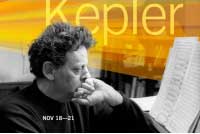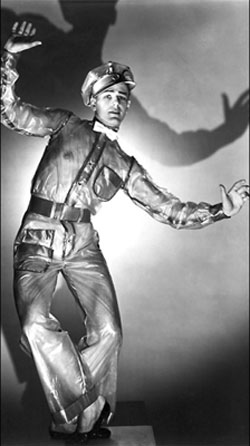 Philip Glass always does the unexpected. Or, as he said to me when we were talking on the phone about his subsequently Oscar-nominated score for Errol Morris’ 2003 The Fog of War, “I’m a bad person to interview because I never stay on the subject.” Well, yes and no. Yes, because Glass’s focus on the work in front of him is unflinching, and no, because his instincts always lead him to surprising solutions. His two-act 155 minute intermission-less new opera Kepler is yet another example of Glass’s wandering, yet disciplined, mind. Premiered at the Linz Opera by American conductor Dennis Russell Davies and his Bruckner Orchester Linz on September 20 2009 as part of that city’s celebrations as this year’s Cultural Capital of Europe, Kepler made the trip to Brooklyn smoothly, carrying a bit of history. Kepler lived in Linz, Mozart’s Symphony #36 was dedicated to it, Bruckner was choir director there — and two of the Nazis’ death camps — Mauthausen and Gusen, whose specialty was getting rid of the intelligentsia, were scant kilometres from its city limits. But then darkness is rarely far from light.
Philip Glass always does the unexpected. Or, as he said to me when we were talking on the phone about his subsequently Oscar-nominated score for Errol Morris’ 2003 The Fog of War, “I’m a bad person to interview because I never stay on the subject.” Well, yes and no. Yes, because Glass’s focus on the work in front of him is unflinching, and no, because his instincts always lead him to surprising solutions. His two-act 155 minute intermission-less new opera Kepler is yet another example of Glass’s wandering, yet disciplined, mind. Premiered at the Linz Opera by American conductor Dennis Russell Davies and his Bruckner Orchester Linz on September 20 2009 as part of that city’s celebrations as this year’s Cultural Capital of Europe, Kepler made the trip to Brooklyn smoothly, carrying a bit of history. Kepler lived in Linz, Mozart’s Symphony #36 was dedicated to it, Bruckner was choir director there — and two of the Nazis’ death camps — Mauthausen and Gusen, whose specialty was getting rid of the intelligentsia, were scant kilometres from its city limits. But then darkness is rarely far from light.
And darkness, as distinct, or in contrast/opposition to — light –is the motor that drives Glass’s Kepler, but not in a Manichean way. Glass is far too subtle to put his cards on one table. Instead, being a practical and practicing Buddhist, he seems to have chosen the unglamorous “Middle Way” which means seeing “things as they are” and in Kepler’s case this is war, strife, and people who dared question him. The mathematician-teacher-astronomer-astrologer and all-round provocateur, who lived from 1571 to 1630, seems to have been at the epicenter of cultural ferment, and of course, the first decade or so of The Thirty Years War (1618-1648), which began more or less as a conflict between Catholics and Protestants and ended up devastating much of Europe, with a death toll as high as 11.5 million people.
Glass dramatizes these stresses in a direct and indirect way. And Glass’s German and Latin libretto, assembled by Austrian artist Martina Winkel, from Kepler’s theoretical writings on the laws of planetary motion and other major discoveries, his enemies list, passages from the Lutheran Bible, and poems by Andreas Gryphius (1616-1664), works both as reportage and evocation. The oratorio-like piece for the 79 member BOL was partially staged here with effective lighting and Karel van Laere’s costumes for its seven soloists — bass-baritone Martin Achrainer as Kepler is the only specified character with Soprano 1 — Sadie Rosales who substituted for the indisposed Cassandra McConnell — Soprano 2 (Cheryl Lichter), Mezzo (Katherina Hebelkova), Tenor (Pedro Velazquez Diaz), Baritone (Seho Chang), and Bass (Florian Spiess) — who functioned as aspects of Kepler’s often beleaguered psyche. The 40 member Linz chorus moved incrementally through the work.
I’d have to agree with my “plus 1” friend that the first 20 or so minutes (after a wonderfully transparent orchestra only prologue with lovely chromatic figures for the strings) was pretty tough going. But things began to pick up when Kepler outlines his theories and his conflicts — the notion that heaven’s not a place inhabited by “divine beings” but a “clockwork” – which, of course, suits Glass’s formal processes perfectly. The chorus, operating as both character and commentator, gave Kepler heft and vivid and enormously varied contrasts. Glass has always written superbly for massed voices — the choruses in Satyagraha (1979) are contemporary landmarks — and those here were both affecting and powerful, especially the “Vanitas! Vanitas!” , which the full vocal ensemble sang on the lip of the stage facing the audience, with the orchestra seated behind. And wouldn’t you know it, my cell rang — being a neophyte in all things cell –which was the only sound in the house as the audience was completely spellbound — and how could they not be — by this arresting passage. I promise to learn how to turn the damned thing off. (more…)
 Old age isn’t for sissies or the timid and I think the same thing can be said about writing for the stage, especially if it’s the operatic one. It took Verdi years before he produced something that worked on the boards. Evan Ziporyn’s no stranger to the stage–he’s written and performed Shadowbang–and his new two-act 140 minute amplified opera
Old age isn’t for sissies or the timid and I think the same thing can be said about writing for the stage, especially if it’s the operatic one. It took Verdi years before he produced something that worked on the boards. Evan Ziporyn’s no stranger to the stage–he’s written and performed Shadowbang–and his new two-act 140 minute amplified opera  It’s sometimes said that composers are either German or French, and American vanguard one Frederic Rzewski, with his much vaunted admiration for Beethoven, is clearly on the German side. But how could he not be when some of his composition teachers like Dallapiccola and Babbitt forsook a flowing lyric line for a jagged dramatic one, whose aim is not to seduce the ear, but to wow with intellectual rigor? But that doesn’t mean that Rzewski’s work is insincere, or lacks power — it has that in spades — but that it tends to be aimed at the mind and not the heart. It’s often confrontational, too. But that’s a good thing because any real musical interaction, like any real human one, has a built in confrontational element, and confrontations help us grow.
It’s sometimes said that composers are either German or French, and American vanguard one Frederic Rzewski, with his much vaunted admiration for Beethoven, is clearly on the German side. But how could he not be when some of his composition teachers like Dallapiccola and Babbitt forsook a flowing lyric line for a jagged dramatic one, whose aim is not to seduce the ear, but to wow with intellectual rigor? But that doesn’t mean that Rzewski’s work is insincere, or lacks power — it has that in spades — but that it tends to be aimed at the mind and not the heart. It’s often confrontational, too. But that’s a good thing because any real musical interaction, like any real human one, has a built in confrontational element, and confrontations help us grow. Dance is always about music, and music is, more often than not, about dance. But how does dance animate music, and music animate dance? This seemed to be the central question when I caught Program 1 of the San Francisco Ballet’s 75th anniversary season at the War Memorial Opera House February 9th. Classical ballet and modern dance sometimes plays against and even ignores the music’s rhythmic structure which would never happen in the deservedly popular Dancing With The Stars. But we rightly or wrongly cut the highbrow forms a bit more slack.
Dance is always about music, and music is, more often than not, about dance. But how does dance animate music, and music animate dance? This seemed to be the central question when I caught Program 1 of the San Francisco Ballet’s 75th anniversary season at the War Memorial Opera House February 9th. Classical ballet and modern dance sometimes plays against and even ignores the music’s rhythmic structure which would never happen in the deservedly popular Dancing With The Stars. But we rightly or wrongly cut the highbrow forms a bit more slack.